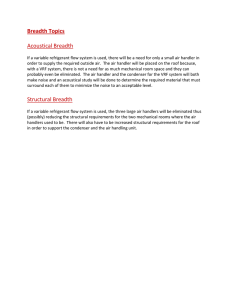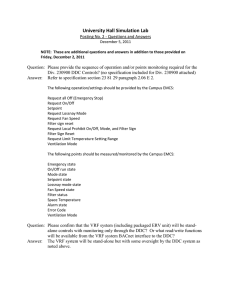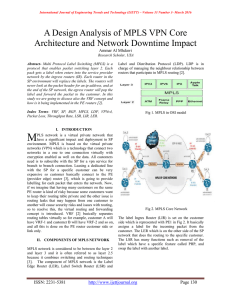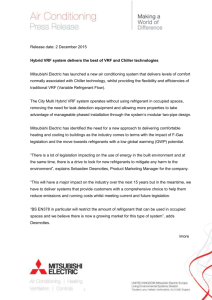MPLS VPN Half-Duplex VRF
advertisement
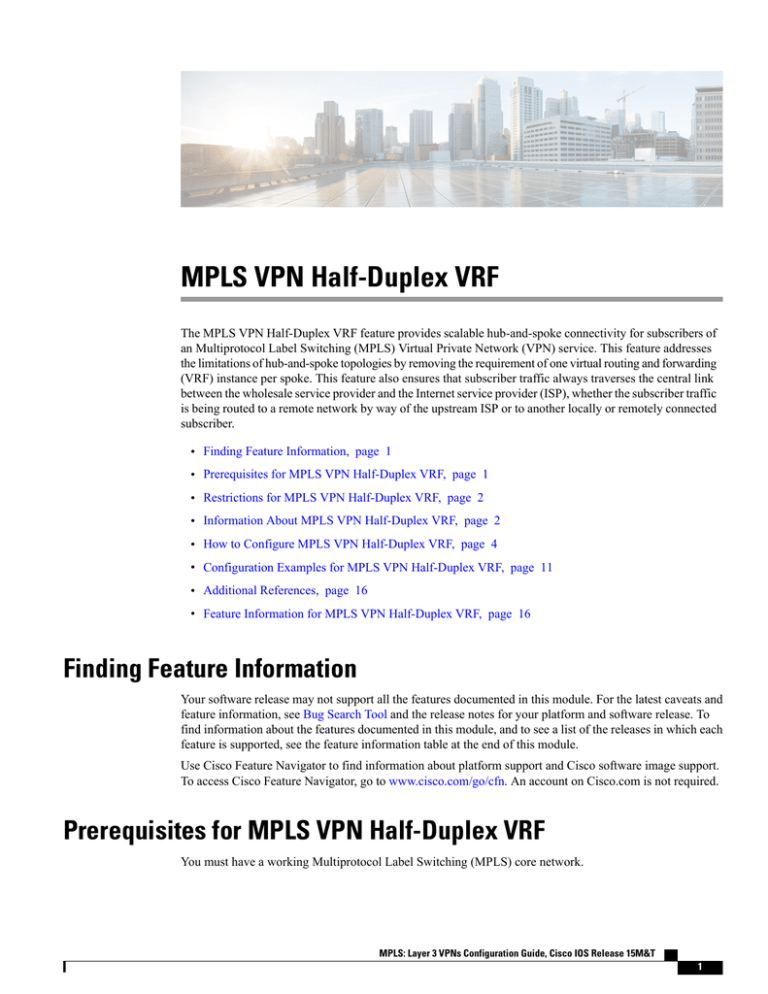
MPLS VPN Half-Duplex VRF
The MPLS VPN Half-Duplex VRF feature provides scalable hub-and-spoke connectivity for subscribers of
an Multiprotocol Label Switching (MPLS) Virtual Private Network (VPN) service. This feature addresses
the limitations of hub-and-spoke topologies by removing the requirement of one virtual routing and forwarding
(VRF) instance per spoke. This feature also ensures that subscriber traffic always traverses the central link
between the wholesale service provider and the Internet service provider (ISP), whether the subscriber traffic
is being routed to a remote network by way of the upstream ISP or to another locally or remotely connected
subscriber.
• Finding Feature Information, page 1
• Prerequisites for MPLS VPN Half-Duplex VRF, page 1
• Restrictions for MPLS VPN Half-Duplex VRF, page 2
• Information About MPLS VPN Half-Duplex VRF, page 2
• How to Configure MPLS VPN Half-Duplex VRF, page 4
• Configuration Examples for MPLS VPN Half-Duplex VRF, page 11
• Additional References, page 16
• Feature Information for MPLS VPN Half-Duplex VRF, page 16
Finding Feature Information
Your software release may not support all the features documented in this module. For the latest caveats and
feature information, see Bug Search Tool and the release notes for your platform and software release. To
find information about the features documented in this module, and to see a list of the releases in which each
feature is supported, see the feature information table at the end of this module.
Use Cisco Feature Navigator to find information about platform support and Cisco software image support.
To access Cisco Feature Navigator, go to www.cisco.com/go/cfn. An account on Cisco.com is not required.
Prerequisites for MPLS VPN Half-Duplex VRF
You must have a working Multiprotocol Label Switching (MPLS) core network.
MPLS: Layer 3 VPNs Configuration Guide, Cisco IOS Release 15M&T
1
MPLS VPN Half-Duplex VRF
Restrictions for MPLS VPN Half-Duplex VRF
Restrictions for MPLS VPN Half-Duplex VRF
The following features are not supported on interfaces configured with the MPLS VPN Half-Duplex VRF
feature:
• Multicast
• MPLS VPN Carrier Supporting Carrier
• MPLS VPN Interautonomous Systems
Information About MPLS VPN Half-Duplex VRF
MPLS VPN Half-Duplex VRF Overview
The MPLS VPN Half-Duplex VRF feature provides:
• The MPLS VPN Half-Duplex VRF feature prevents local connectivity between subscribers at the spoke
provider edge (PE) device and ensures that a hub site provides subscriber connectivity. Any sites that
connect to the same PE device must forward intersite traffic using the hub site. This ensures that the
routing done at the spoke site moves from the access-side interface to the network-side interface or from
the network-side interface to the access-side interface, but never from the access-side interface to the
access-side interface.
• The MPLS VPN Half-Duplex VRF feature prevents situations where the PE device locally switches the
spokes without passing the traffic through the upstream Internet service provider (ISP). This prevents
subscribers from directly connecting to each other, which causes the wholesale service provider to lose
revenue.
• The MPLS VPN Half-Duplex VRF feature improves scalability by removing the requirement of one
virtual routing and forwarding (VRF) instance per spoke. If the feature is not configured, when spokes
are connected to the same PE device each spoke is configured in a separate VRF to ensure that the traffic
between the spokes traverses the central link between the wholesale service provider and the ISP.
However, this configuration is not scalable. When many spokes are connected to the same PE device,
configuration of VRFs for each spoke becomes quite complex and greatly increases memory usage. This
is especially true in large-scale wholesale service provider environments that support high-density remote
access to Layer 3 Virtual Private Networks (VPNs).
MPLS: Layer 3 VPNs Configuration Guide, Cisco IOS Release 15M&T
2
MPLS VPN Half-Duplex VRF
Upstream and Downstream VRFs
The figure below shows a sample hub-and-spoke topology.
Figure 1: Hub-and-Spoke Topology
Upstream and Downstream VRFs
The MPLS VPN Half-Duplex VRF feature uses two unidirectional virtual routing and forwarding (VRF)
instances to forward IP traffic between the spokes and the hub PE device:
• The upstream VRF forwards IP traffic from the spokes toward the hub provider edge (PE) device. This
VRF typically contains only a default route but might also contain summary routes and several default
routes. The default route points to the interface on the hub PE device that connects to the upstream
Internet service provider (ISP). The device dynamically learns about the default route from the routing
updates that the hub PE device or home gateway sends.
Note
Although the upstream VRF is typically populated from the hub, it is possible also to have a separate local
upstream interface on the spoke PE for a different local service that would not be required to go through
the hub: for example, a local Domain Name System (DNS) or game server service.
• The downstream VRF forwards traffic from the hub PE device back to the spokes. This VRF can contain:
• PPP peer routes for the spokes and per-user static routes received from the authentication,
authorization, and accounting (AAA) server or from the Dynamic Host Control Protocol (DHCP)
server
• Routes imported from the hub PE device
• Border Gateway Protocol (BGP), Open Shortest Path First (OSPF), Routing Information Protocol
(RIP), or Enhanced Interior Gateway Routing Protocol (EIGRP) dynamic routes for the spokes
The spoke PE device redistributes routes from the downstream VRF into Multiprotocol Border Gateway
Protocol (MP-BGP). That device typically advertises a summary route across the Multiprotocol Label Switching
(MPLS) core for the connected spokes. The VRF configured on the hub PE device imports the advertised
summary route.
MPLS: Layer 3 VPNs Configuration Guide, Cisco IOS Release 15M&T
3
MPLS VPN Half-Duplex VRF
Reverse Path Forwarding Check
Reverse Path Forwarding Check
The Reverse Path Forwarding (RPF) check ensures that an IP packet that enters a device uses the correct
inbound interface. The MPLS VPN Half-Duplex VRF feature supports unicast RPF check on the spoke-side
interfaces. Because different virtual routing and forwarding (VRF) instances are used for downstream and
upstream forwarding, the RPF mechanism ensures that source address checks occur in the downstream VRF.
Unicast RPF is disabled by default. .
How to Configure MPLS VPN Half-Duplex VRF
Configuring the Upstream and Downstream VRFs on the Spoke PE Device
SUMMARY STEPS
1. enable
2. configure terminal
3. vrf definition vrf-name
4. rd route-distinguisher
5. address-family {ipv4 | ipv6}
6. route-target {import | export | both} route-target-ext-community
7. exit-address-family
8. end
DETAILED STEPS
Step 1
Command or Action
Purpose
enable
Enables privileged EXEC mode.
Example:
• Enter your password if prompted.
Device> enable
Step 2
configure terminal
Enters global configuration mode.
Example:
Device# configure terminal
Step 3
vrf definition vrf-name
Example:
Configures a virtual routing and forwarding (VRF) table and enters VRF
configuration mode.
• The vrf-name argument is the name of the VRF.
Device(config)# vrf definition vrf1
MPLS: Layer 3 VPNs Configuration Guide, Cisco IOS Release 15M&T
4
MPLS VPN Half-Duplex VRF
Configuring the Upstream and Downstream VRFs on the Spoke PE Device
Step 4
Command or Action
Purpose
rd route-distinguisher
Creates routing and forwarding tables for a VRF.
Example:
Device(config-vrf)# rd 100:1
• The route-distinguisher argument specifies to add an 8-byte value to
an IPv4 prefix to create a Virtual Private Network (VPN) IPv4 prefix.
You can enter a route distinguisher in either of these formats:
• 16-bit autonomous system number (ASN): your 32-bit number
For example, 101:3.
• 32-bit IP address: your 16-bit number For example,
192.168.122.15:1.
Step 5
address-family {ipv4 | ipv6}
Example:
Device(config-vrf) address-family
ipv4
Enters VRF address family configuration mode to specify an address family
for a VRF.
• The ipv4 keyword specifies an IPv4 address family for a VRF.
• The ipv6 keyword specifies an IPv6 address family for a VRF.
Note
Step 6
route-target {import | export | both}
route-target-ext-community
Example:
Device(config-vrf-af)# route-target
both 100:2
The MPLS VPN Half Duplex VRF feature supports only the IPv4
address family.
Creates a route-target extended community for a VRF.
• The import keyword specifies to import routing information from the
target VPN extended community.
• The export keyword specifies to export routing information to the
target VPN extended community.
• The both keyword specifies to import both import and export routing
information to the target VPN extended community.
• The route-target-ext-community argument adds the route-target
extended community attributes to the VRF’s list of import, export, or
both (import and export) route-target extended communities.
Step 7
exit-address-family
Exits VRF address family configuration mode.
Example:
Device(config-vrf-af)#
exit-address-family
Step 8
end
Returns to privileged EXEC mode.
Example:
Device(config-vrf)# end
MPLS: Layer 3 VPNs Configuration Guide, Cisco IOS Release 15M&T
5
MPLS VPN Half-Duplex VRF
Associating a VRF with an Interface
Associating a VRF with an Interface
Perform the following task to associate a virtual routing and forwarding (VRF) instance with an interface,
which activates the VRF.
SUMMARY STEPS
1. enable
2. configure terminal
3. interface type number
4. vrf forwarding vrf-name [downstream vrf-name2
5. ip address ip-address mask [secondary]
6. end
DETAILED STEPS
Step 1
Command or Action
Purpose
enable
Enables privileged EXEC mode.
Example:
• Enter your password if prompted.
Device> enable
Step 2
configure terminal
Enters global configuration mode.
Example:
Device# configure terminal
Step 3
interface type number
Example:
Device(config)# interface Ethernet 0/1
Step 4
vrf forwarding vrf-name [downstream
vrf-name2
Example:
Device(config-if)# vrf forwarding vrf1
Step 5
ip address ip-address mask [secondary]
Example:
Device(config-if)# ip address
10.24.24.24 255.255.255.255
Configures an interface type and enters interface configuration mode.
• The type argument identifies the type of interface to be configured.
• The number argument identifies the port, connector, or interface
card number.
Associates a VRF with an interface or subinterface.
• The vrf-name argument is the name of the VRF.
• The downstream vrf-name2 keyword and argument combination
is the name of the downstream VRF into which peer and per-user
routes are installed.
Sets a primary or secondary IP address for an interface.
• The ip-address argument is the IP address.
• The mask argument is the mask of the associated IP subnet.
MPLS: Layer 3 VPNs Configuration Guide, Cisco IOS Release 15M&T
6
MPLS VPN Half-Duplex VRF
Configuring the Downstream VRF for an AAA Server
Command or Action
Purpose
• The secondary keyword specifies that the configured address is
a secondary IP address. If this keyword is omitted, the configured
address is the primary IP address.
Step 6
Returns to privileged EXEC mode.
end
Example:
Device(config-if) end
Configuring the Downstream VRF for an AAA Server
To configure the downstream VRF for an AAA (RADIUS) server in broadband or remote access situations,
enter the following Cisco attribute value:
lcp:interface-config=ip vrf forwarding U downstream D
In standard VPN situations, enter instead the following Cisco attribute value:
ip:vrf-id=U downstream D
Verifying the MPLS VPN Half-Duplex VRF Configuration
SUMMARY STEPS
1. show vrf [ipv4 | ipv6] [brief | detail | id | interfaces | lock | select] [vrf-name]
2. show ip route vrf vrf-name
3. show running-config [interface type number]
DETAILED STEPS
Step 1
show vrf [ipv4 | ipv6] [brief | detail | id | interfaces | lock | select] [vrf-name]
Displays information about all of the virtual routing and forwarding (VRF) instances configured on the device, including
the downstream VRF for each associated interface or virtual access interface (VAI):
Example:
Device# show vrf
Name
Default RD
Down
100:1
100:3
Up
100:2
Interfaces
POS3/0/3 [D]
POS3/0/1 [D]
Loopback2
Virtual-Access3 [D]
Virtual-Access4 [D]
POS3/0/3
MPLS: Layer 3 VPNs Configuration Guide, Cisco IOS Release 15M&T
7
MPLS VPN Half-Duplex VRF
Verifying the MPLS VPN Half-Duplex VRF Configuration
100:4
POS3/0/1
Virtual-Access3
Use the show vrf detail vrf-name command to display detailed information about the VRF you specify, including all
interfaces, subinterfaces, and VAIs associated with the VRF.
If you do not specify a value for the vrf-name argument, detailed information about all of the VRFs configured on the
device appears.
The following example shows how to display detailed information for the VRF called vrf1, in a broadband or remote
access case:
Example:
Device# show vrf detail vrf1
VRF D; default RD 2:0; default VPNID <not set>
Interfaces:
Loopback2
Virtual-Access3 [D] Virtual-Access4 [D]
Connected addresses are not in global routing table
Export VPN route-target communities
RT:2:0
Import VPN route-target communities
RT:2:1
No import route-map
No export route-map
VRF U; default RD 2:1; default VPNID <not set>
Interfaces:
Virtual-Access3
Virtual-Access4
Connected addresses are not in global routing table
No Export VPN route-target communities
Import VPN route-target communities
RT:2:1
No import route-map
No export route-map
The following example shows the VRF detail in a standard Virtual Private Network (VPN) situation:
Example:
Device# show vrf detail
VRF Down; default RD 100:1; default VPNID <not set> VRF Table ID = 1
Description: import only from hub-pe
Interfaces:
Pos3/0/3 [D]
Pos3/0/1:0.1 [D]
Connected addresses are not in global routing table
Export VPN route-target communities
RT:100:0
Import VPN route-target communities
RT:100:1
No import route-map
No export route-map
VRF label distribution protocol: not configured
VRF Up; default RD 100:2; default VPNID <not set> VRF Table ID = 2
Interfaces:
Pos3/0/1
Pos3/0/3
Connected addresses are not in global routing table
No Export VPN route-target communities
Import VPN route-target communities
RT:100:1
No import route-map
No export route-map
VRF label distribution protocol: not configured
Step 2
show ip route vrf vrf-name
MPLS: Layer 3 VPNs Configuration Guide, Cisco IOS Release 15M&T
8
MPLS VPN Half-Duplex VRF
Verifying the MPLS VPN Half-Duplex VRF Configuration
Displays the IP routing table for the VRF you specify, and information about the per-user routes installed in the downstream
VRF.
The following example shows how to display the routing table for the downstream VRF named D, in a broadband or
remote access situation:
Example:
Device# show ip route vrf D
Routing Table: D
Codes: C - connected, S - static, R - RIP, M - mobile, B - BGP
D - EIGRP, EX - EIGRP external, O - OSPF, IA - OSPF inter area
N1 - OSPF NSSA external type 1, N2 - OSPF NSSA external type 2
E1 - OSPF external type 1, E2 - OSPF external type 2
I - IS-IS, L1 - IS-IS level-1, L2 - IS-IS level-2, ia - IS-IS interarea
* - candidate default, U - per-user static route, o - ODR
P - periodic downloaded static route
Gateway of last resort is not set
10.0.0.0/8 is variably subnetted, 5 subnets, 2 masks
U
10.0.0.2/32 [1/0] via 10.0.0.1
S
10.0.0.0/8 is directly connected, Null0
U
10.0.0.5/32 [1/0] via 10.0.0.2
C
10.8.1.2/32 is directly connected, Virtual-Access4
C
10.8.1.1/32 is directly connected, Virtual-Access3
The following example shows how to display the routing table for the downstream VRF named Down, in a standard
VPN situation:
Example:
Device# show ip route vrf Down
Routing Table: Down
Codes: C - connected, S - static, R - RIP, M - mobile, B - BGP
D - EIGRP, EX - EIGRP external, O - OSPF, IA - OSPF inter area
N1 - OSPF NSSA external type 1, N2 - OSPF NSSA external type 2
E1 - OSPF external type 1, E2 - OSPF external type 2
I - IS-IS, su - IS-IS summary, L1 - IS-IS level-1, L2 - IS-IS level-2
ia - IS-IS inter area, * - candidate default, U - per-user static route
o - ODR, P - periodic downloaded static route
Gateway of last resort is 10.13.13.13 to network 0.0.0.0
C 10.2.0.0/8 is directly connected, Pos3/0/3
10.3.0.0/32 is subnetted, 1 subnets
B
10.4.16.16 [200/0] via 10.13.13.13, 1w3d
B 10.6.0.0/8 [200/0] via 10.13.13.13, 1w3d
C 10.0.0.0/8 is directly connected, Pos3/0/1
10.7.0.0/16 is subnetted, 1 subnets
B
10.7.0.0 [20/0] via 10.0.0.2, 1w3d
10.0.6.0/32 is subnetted, 1 subnets
B
10.0.6.14 [20/0] via 10.0.0.2, 1w3d
10.8.0.0/32 is subnetted, 1 subnets
B
10.8.15.15 [20/0] via 10.0.0.2, 1w3d
B*
0.0.0.0/0 [200/0] via 10.0.0.13, 1w3d
The following example shows how to display the routing table for the upstream VRF named U in a broadband or remote
access situation:
Example:
Device# show ip route vrf U
Routing Table: U
Codes: C - connected, S - static, R - RIP, M - mobile, B - BGP
D - EIGRP, EX - EIGRP external, O - OSPF, IA - OSPF inter area
MPLS: Layer 3 VPNs Configuration Guide, Cisco IOS Release 15M&T
9
MPLS VPN Half-Duplex VRF
Verifying the MPLS VPN Half-Duplex VRF Configuration
N1 - OSPF NSSA external type 1, N2 - OSPF NSSA external type 2
E1 - OSPF external type 1, E2 - OSPF external type 2
I - IS-IS, L1 - IS-IS level-1, L2 - IS-IS level-2, ia - IS-IS interarea
* - candidate default, U - per-user static route, o - ODR
P - periodic downloaded static route
Gateway of last resort is 192.168.0.20 to network 0.0.0.0
10.0.0.0/32 is subnetted, 1 subnets
C
10.0.0.8 is directly connected, Loopback2
B*
0.0.0.0/0 [200/0] via 192.168.0.20, 1w5d
The following example shows how to display the routing table for the upstream VRF named Up in a standard VPN
situation:
Example:
Device# show ip route vrf Up
Routing Table: Up
Codes: C - connected, S - static, R - RIP, M - mobile, B - BGP
D - EIGRP, EX - EIGRP external, O - OSPF, IA - OSPF inter area
N1 - OSPF NSSA external type 1, N2 - OSPF NSSA external type 2
E1 - OSPF external type 1, E2 - OSPF external type 2
I - IS-IS, su - IS-IS summary, L1 - IS-IS level-1, L2 - IS-IS level-2
ia - IS-IS inter area, * - candidate default, U - per-user static route
o - ODR, P - periodic downloaded static route
Gateway of last resort is 10.13.13.13 to network 0.0.0.0
10.2.0.0/32 is subnetted, 1 subnets
C
10.2.0.1 is directly connected, Pos3/0/3
10.3.0.0/32 is subnetted, 1 subnets
B
10.3.16.16 [200/0] via 10.13.13.13, 1w3d
B 10.6.0.0/8 [200/0] via 10.13.13.13, 1w3d
10.0.0.0/32 is subnetted, 1 subnets
C
10.0.0.1 is directly connected, Pos3/0/1
B*
0.0.0.0/0 [200/0] via 10.13.13.13, 1w3d
Step 3
show running-config [interface type number]
Displays information about the interface you specify, including information about the associated upstream and downstream
VRFs.
The following example shows how to display information about subinterface POS 3/0/1:
Example:
Device# show running-config interface POS 3/0/1
Building configuration...
Current configuration : 4261 bytes
!
interface POS3/0/1
ip vrf forwarding Up downstream Down
ip address 10.0.0.1 255.0.0.0
end
MPLS: Layer 3 VPNs Configuration Guide, Cisco IOS Release 15M&T
10
MPLS VPN Half-Duplex VRF
Configuration Examples for MPLS VPN Half-Duplex VRF
Configuration Examples for MPLS VPN Half-Duplex VRF
Examples: Configuring the Upstream and Downstream VRFs on the Spoke PE
Device
The following example configures an upstream virtual routing and forwarding (VRF) instance named Up:
Device> enable
Device# configure terminal
Device(config)# vrf definition Up
Device(config-vrf)# rd 1:0
Device(config-vrf)# address-family ipv4
Device(config-vrf-af)# route-target import 1:0
Device(config-vrf-af)# exit-address-family
The following example configures a downstream VRF named Down:
Device> enable
Device# configure terminal
Device(config)# vrf definition Down
Device(config-vrf)# rd 1:8
Device(config-vrf)# address-family ipv4
Device(config-vrf-af)# route-target import 1:8
Device(config-vrf-af)# exit-address-family
Example: Associating a VRF with an Interface
The following example associates the virtual routing and forwarding (VRF) instance named Up with POS
3/0/1 subinterface and specifies the downstream VRF named Down:
Device> enable
Device# configure terminal
Device(config)# interface POS 3/0/1
Device(config-if)# vrf forwarding Up downstream Down
Device(config-if)# ip address 10.0.0.1 255.0.0.0
MPLS: Layer 3 VPNs Configuration Guide, Cisco IOS Release 15M&T
11
MPLS VPN Half-Duplex VRF
Example Configuring MPLS VPN Half-Duplex VRF Using Static CE-PE Routing
Example Configuring MPLS VPN Half-Duplex VRF Using Static CE-PE Routing
This example uses the hub-and-spoke topology shown in the figure below with local authentication (that is,
the RADIUS server is not used):
Figure 2: Sample Topology
vrf definition D
rd 1:8
address-family ipv4
route-target export 1:100
exit-address-family
!
vrf definition U
rd 1:0
address-family ipv4
route-target import 1:0
exit-address-family
!
ip cef
vpdn enable
!
vpdn-group U
accept-dialin
protocol pppoe
virtual-template 1
!
interface Loopback 2
vrf forwarding U
ip address 10.0.0.8 255.255.255.255
!
interface ATM 2/0
description Mze ATM3/1/2
no ip address
no atm ilmi-keepalive
pvc 0/16 ilmi
!
pvc 3/100
protocol pppoe
!
pvc 3/101
protocol pppoe
!
MPLS: Layer 3 VPNs Configuration Guide, Cisco IOS Release 15M&T
12
MPLS VPN Half-Duplex VRF
Example: Configuring MPLS VPN Half-Duplex VRF Using RADIUS Server and Static CE-PE Routing
Example: Configuring MPLS VPN Half-Duplex VRF Using RADIUS Server and
Static CE-PE Routing
The following example shows how to connect two Point-to-Point Protocol over Ethernet (PPPoE) clients to
a single virtual routing and forwarding (VRF) pair on the spoke provider edge (PE) device named Device C.
Although both PPPoE clients are configured in the same VRF, all communication occurs using the hub PE
device. Half-duplex VRFs are configured on the spoke PE. The client configuration is downloaded to the
spoke PE from the RADIUS server.
This example uses the hub-and-spoke topology shown in the figure above.
Note
The wholesale provider can forward the user authentication request to the corresponding ISP. If the ISP
authenticates the user, the wholesale provider appends the VRF information to the request that goes back
to the PE device.
aaa new-model
!
aaa group server radius R
server 10.0.20.26 auth-port 1812 acct-port 1813
!
aaa authentication ppp default group radius
aaa authorization network default group radius
!
vrf defintion D
description Downstream VRF - to spokes
rd 1:8
address-family ipv4
route-target export 1:100
exit-address-family
!
vrf definition U
description Upstream VRF - to hub
rd 1:0
address-family ipv4
route-target import 1:0
exit-address-family
!
ip cef
vpdn enable
!
vpdn-group U
accept-dialin
protocol pppoe
virtual-template 1
!
interface Loopback2
vrf forwarding U
ip address 10.0.0.8 255.255.255.255
!
interface ATM2/0
pvc 3/100
protocol pppoe
!
pvc 3/101
protocol pppoe
!
interface virtual-template 1
no ip address
ppp authentication chap
!
router bgp 1
no synchronization
MPLS: Layer 3 VPNs Configuration Guide, Cisco IOS Release 15M&T
13
MPLS VPN Half-Duplex VRF
Example: Configuring MPLS VPN Half-Duplex VRF Using Dynamic CE-PE Routing
neighbor 172.16.0.34 remote-as 1
neighbor 172.16.0.34 update-source Loopback0
no auto-summary
!
address-family vpnv4
neighbor 172.16.0.34 activate
neighbor 172.16.0.34 send-community extended
auto-summary
exit-address-family
!
address-family ipv4 vrf U
no auto-summary
no synchronization
exit-address-family
!
address-family ipv4 vrf D
redistribute static
no auto-summary
no synchronization
exit-address-family
!
ip local pool U-pool 10.8.1.1 2.8.1.100
ip route vrf D 10.0.0.0 255.0.0.0 Null0
!
radius-server host 10.0.20.26 auth-port 1812 acct-port 1813
radius-server key cisco
Example: Configuring MPLS VPN Half-Duplex VRF Using Dynamic CE-PE
Routing
The following example shows how to use Open Shortest Path First (OSPF) to dynamically advertise the routes
on the spoke sites.
This example uses the hub-and-spoke topology shown in the figure above.
Creating the VRFs
vrf definition Down
rd 100:1
address-family ipv4
route-target export 100:0
exit-address-family
!
vrf definition Up
rd 100:2
address-family ipv4
route-target import 100:1
exit-address-family
Enabling MPLS
mpls ldp graceful-restart
mpls ldp router-id Loopback0 force
mpls label protocol ldp
Configuring BGP Toward Core
router bgp 100
no bgp default ipv4-unicast
bgp log-neighbor-changes
bgp graceful-restart restart-time 120
bgp graceful-restart stalepath-time 360
MPLS: Layer 3 VPNs Configuration Guide, Cisco IOS Release 15M&T
14
MPLS VPN Half-Duplex VRF
Example: Configuring MPLS VPN Half-Duplex VRF Using Dynamic CE-PE Routing
bgp graceful-restart
neighbor 10.13.13.13
neighbor 10.13.13.13
!
address-family vpnv4
neighbor 10.13.13.13
neighbor 10.13.13.13
bgp scan-time import
exit-address-family
remote-as 100
update-source Loopback0
activate
send-community extended
5
Configuring BGP Toward Edge
address-family ipv4 vrf Up
no auto-summary
no synchronization
exit-address-family
!
address-family ipv4 vrf Down
redistribute ospf 1000 vrf Down
no auto-summary
no synchronization
exit-address-family
Spoke PE’s Core-Facing Interfaces and Processes
interface Loopback 0
ip address 10.11.11.11 255.255.255.255
!
interface POS 3/0/2
ip address 10.0.1.1 255.0.0.0
mpls label protocol ldp
mpls ip
!
router ospf 100
log-adjacency-changes
auto-cost reference-bandwidth 1000
nsf enforce global
redistribute connected subnets
network 10.11.11.11 0.0.0.0 area 100
network 10.0.1.0 0.255.255.255 area 100
Spoke PE’s Edge-Facing Interfaces and Processes
interface Loopback 100
vrf forwarding Down
ip address 10.22.22.22 255.255.255.255
!
interface POS 3/0/1
vrf forwarding Up downstream Down
ip address 10.0.0.1 255.0.0.0
!
interface POS 3/0/3
vrf forwarding Up downstream Down
ip address 10.2.0.1 255.0.0.0
!
router ospf 1000 vrf Down
router-id 10.22.22.22
log-adjacency-changes
auto-cost reference-bandwidth 1000
nsf enforce global
redistribute connected subnets
redistribute bgp 100 metric-type 1 subnets
network 10.22.22.22 0.0.0.0 area 300
network 10.0.0.0 0.255.255.255 area 300
network 10.2.0.0 0.255.255.255 area 300
default-information originate
MPLS: Layer 3 VPNs Configuration Guide, Cisco IOS Release 15M&T
15
MPLS VPN Half-Duplex VRF
Additional References
Additional References
Related Documents
Related Topic
Document Title
Cisco IOS commands
Cisco Master Command List, All Releases
MPLS and MPLS applications commands
Cisco IOS Multiprotocol Label Switching Command
Reference
MPLS VPNs
“MPLS Virtual Private Networks” module
Configuring IPv4 and IPv6 VRFs
“MPLS VPN VRF CLI for IPv4 and IPv6 VPNs”
module
Standards and RFCs
Standard/RFC
Title
RFC 2547
BGP/MPLS VPNs
Technical Assistance
Description
Link
The Cisco Support and Documentation website
http://www.cisco.com/cisco/web/support/index.html
provides online resources to download documentation,
software, and tools. Use these resources to install and
configure the software and to troubleshoot and resolve
technical issues with Cisco products and technologies.
Access to most tools on the Cisco Support and
Documentation website requires a Cisco.com user ID
and password.
Feature Information for MPLS VPN Half-Duplex VRF
The following table provides release information about the feature or features described in this module. This
table lists only the software release that introduced support for a given feature in a given software release
train. Unless noted otherwise, subsequent releases of that software release train also support that feature.
Use Cisco Feature Navigator to find information about platform support and Cisco software image support.
To access Cisco Feature Navigator, go to www.cisco.com/go/cfn. An account on Cisco.com is not required.
MPLS: Layer 3 VPNs Configuration Guide, Cisco IOS Release 15M&T
16
MPLS VPN Half-Duplex VRF
Feature Information for MPLS VPN Half-Duplex VRF
Table 1: Feature Information for MPLS VPN Half-Duplex VRF
Feature Name
Releases
Feature Information
MPLS VPN - Half Duplex VRF
(HDVRF) Support with Static
Routing
12.3(6)
This feature ensures that VPN
clients that connect to the same PE
device at the edge of the MPLS
VPN use the hub site to
communicate.
12.3(11)T
12.2(28)SB
Cisco IOS XE Release 2.5
In Cisco IOS Release 12.3(6), this
feature was introduced.
In Cisco IOS Release 12.4(20)T,
this feature was integrated.
In Cisco IOS Release 12.2(28)SB,
this feature was integrated
In Cisco IOS XE Release 2.5, this
feature was implemented on the
Cisco ASR 1000 Series
Aggregation Services Routers.
MPLS VPN Half-Duplex VRF
12.2(28)SB2
12.4(20)T
12.2(33)SRC
Cisco IOS XE Release 2.5
In Cisco IOS Release 12.2(28)SB2,
support for dynamic routing
protocols was added.
In Cisco IOS Release 12.4(20)T,
this feature was integrated.
In Cisco IOS Release
12.2(33)SRC, this feature was
integrated.
In Cisco IOS XE Release 2.5, this
feature was integrated.
The following commands were
introduced or modified: ip vrf
forwarding (interface
configuration), show ip interface,
show vrf.
MPLS: Layer 3 VPNs Configuration Guide, Cisco IOS Release 15M&T
17
MPLS VPN Half-Duplex VRF
Feature Information for MPLS VPN Half-Duplex VRF
MPLS: Layer 3 VPNs Configuration Guide, Cisco IOS Release 15M&T
18



